| Article ID | Journal | Published Year | Pages | File Type |
|---|---|---|---|---|
| 4341210 | Neuroscience | 2007 | 10 Pages |
Valproic acid (VPA), a widely prescribed drug for seizures and bipolar disorder, has been shown to be an inhibitor of histone deacetylase (HDAC). Our previous study has demonstrated that VPA pretreatment reduces lipopolysaccharide (LPS)-induced dopaminergic (DA) neurotoxicity through the inhibition of microglia over-activation. The aim of this study was to determine the mechanism underlying VPA-induced attenuation of microglia over-activation using rodent primary neuron/glia or enriched glia cultures. Other histone deacetylase inhibitors (HDACIs) were compared with VPA for their effects on microglial activity. We found that VPA induced apoptosis of microglia cells in a time- and concentration-dependent manner. VPA-treated microglial cells showed typical apoptotic hallmarks including phosphatidylserine externalization, chromatin condensation and DNA fragmentation. Further studies revealed that trichostatin A (TSA) and sodium butyrate (SB), two structurally dissimilar HDACIs, also induced microglial apoptosis. The apoptosis of microglia was accompanied by the disruption of mitochondrial membrane potential and the enhancement of acetylation levels of the histone H3 protein. Moreover, pretreatment with SB or TSA caused a robust decrease in LPS-induced pro-inflammatory responses and protected DA neurons from damage in mesencephalic neuron–glia cultures. Taken together, our results shed light on a novel mechanism whereby HDACIs induce neuroprotection and underscore the potential utility of HDACIs in preventing inflammation-related neurodegenerative disorders such as Parkinson’s disease.
